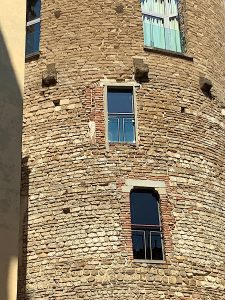
Age
Unknown
Designer
Unknown
The tower, which overlooks the small square of Sant’ Elisabetta is considered by many to be the oldest building in Florence. According to some, the building dates back to the Byzantine period, others may refer to the Lombard period; excavations carried out in the eighties of the twentieth century show that the tower rests on more ancient foundations, of Roman times. The foundations, in fact, rest on a Roman circular wall that probably surrounded a swimming pool or a thermal structure of the Roman Florentia. This exedra-like structure, used as a base, is thought to have determined the unusual semicircular shape of the tower, an almost unique case in Florence. The most recent documents that attest to its existence date back to 1268 when it was used as a women’s prison (hence the name, “clown”, or straw beds of the prison). Later it was used as a bell tower of the church of San Michele alla Trombe. At the beginning of the twentieth century, the tower appeared to be incorporated in a building used as a hotel (Hotel del Giglio) and emerged only the terminal part of the Pagliazza. When the hotel closed (1967) the tower was bought by the National Insurance Institute and subjected to a restoration through which they tried to bring it back to the appearance it presented in the fifteenth century. Therefore, today it is possible to observe the cylindrical volume that has an exposed masonry realized with rows of limestone, sandstone and bricks; there are a large arch to the ground level and large arched windows on the top floor. Currently, the structure is occupied by the Hotel Brunelleschi and a small museum that documents the various materials found during the excavations. In the museum, there are pottery pieces from Roman times, artefacts from the early and late Middle Ages, and Renaissance and post-Renaissance ceramics (mainly production of Montelupo in the province of Florence).
The tower shows row stone made by Alberese Limestone, rare Pietraforte and Pietra Serena Sandstones, and Brick held together by Mortar. The windows display a partial finishes in Pietra Serena Sandstone. There are Plaster parts.

